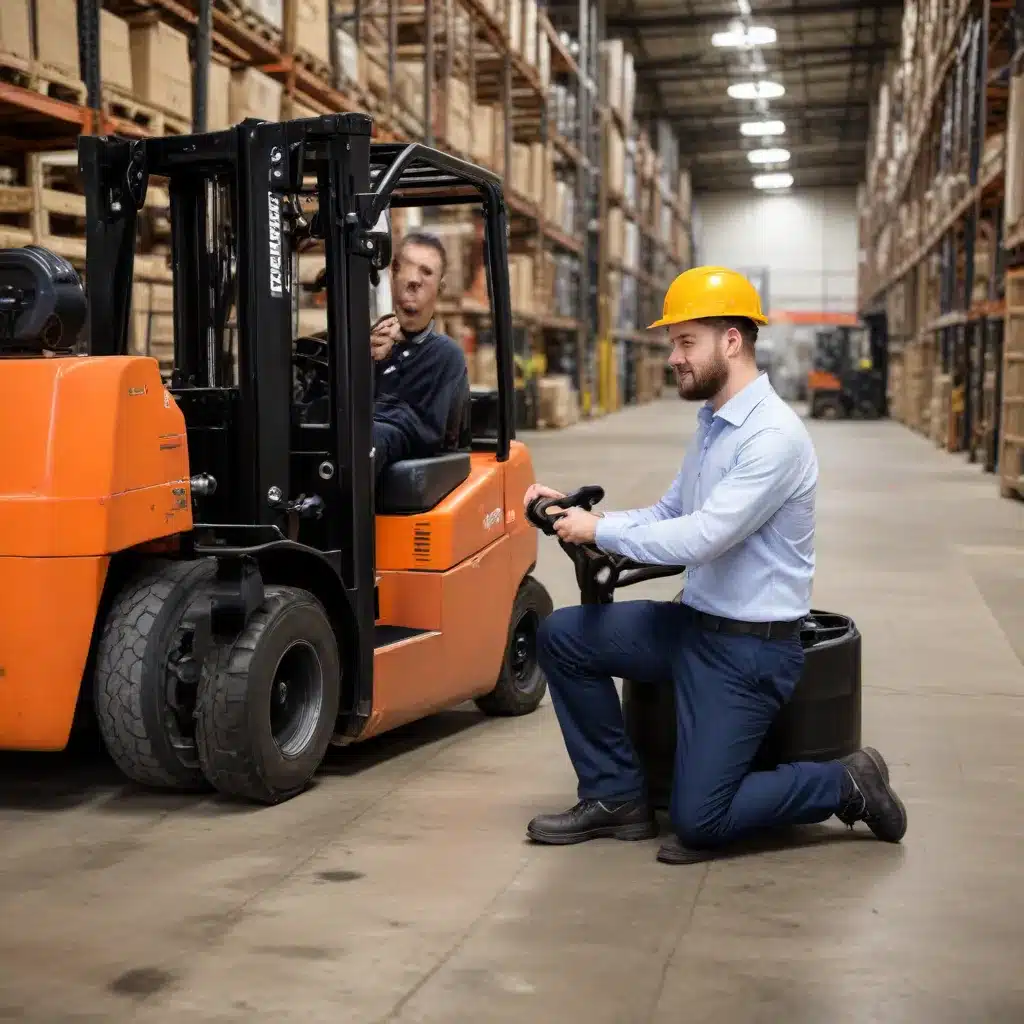
Prioritizing Safety Through an Integrated Approach
Ensuring forklift operator safety is a critical component of any successful warehouse or logistics operation. While investing in advanced equipment and implementing comprehensive training programs are essential, cultivating a strong safety culture requires a more holistic approach. By integrating various safety elements, you can maximize the impact of your efforts and drive meaningful, long-term behavioral changes among your forklift fleet.
As Crown Equipment emphasizes, an “integrated approach to forklift safety” considers key factors that can positively contribute to employee well-being. This includes leveraging connectivity solutions to set measurable safety goals, communicating the “why” and “how” behind safety initiatives, and empowering employees to take ownership of their own and their colleagues’ safety.
“Maximizing your investments in safety – and striving for sustained focus and improvement – requires supporting each of the components of a comprehensive safety program with strategies for managing behavior and organizational change.”
Harnessing Forklift Connectivity for Data-Driven Safety
Forklift connectivity solutions play a crucial role in enhancing safety performance. By integrating forklift operations with centralized operator and fleet management systems, you can gain valuable insights to drive continuous improvement. These systems enable:
- Accurate Benchmarking: Measure current safety performance and identify the root causes of accidents or product damage.
- Personalized Goal-Setting: Set specific safety goals for individual operators and encourage behavioral changes through targeted feedback.
- Access Control: Limit equipment access to only authorized and properly trained operators, reducing the risk of unsafe operation.
- Automated Compliance: Streamline safety-related processes, such as pre-shift inspections and operator certification tracking, to ensure consistent adherence to regulations.
Implementing these connectivity-enabled features can empower your organization to make data-driven decisions and instill a stronger safety mindset among your forklift fleet.
Navigating the Challenges of Change
Introducing new safety technologies and processes can often be met with resistance from employees. To overcome this hurdle, it’s crucial to address the human element and foster greater workforce engagement.
Textron highlights seven key considerations that can help ease the transition and encourage buy-in from your forklift operators:
- Communicate the “Why”: Clearly explain the rationale behind the changes, emphasizing how they align with the organization’s safety goals and benefit the workforce.
- Involve Employees: Seek input from operators during the planning and implementation stages, empowering them to contribute to the process.
- Provide Training: Ensure all affected personnel receive comprehensive training on the new technologies, processes, and safety protocols.
- Recognize Achievements: Celebrate individual and team accomplishments to reinforce the positive impact of the changes.
- Encourage Peer-to-Peer Engagement: Empower operators to take an active role in monitoring each other’s safety practices and providing feedback.
- Address Concerns: Actively listen to operator concerns and address them in a timely and transparent manner.
- Foster a Culture of Accountability: Establish clear expectations and hold all employees accountable for maintaining safe practices.
By addressing the human aspect of change, you can cultivate a workforce that is engaged, motivated, and committed to the organization’s safety goals.
Leveraging Peer-to-Peer Communication
Effective communication is the cornerstone of a robust safety culture. While formal training and top-down directives play a vital role, peer-to-peer interactions can be equally influential in shaping operator behavior and fostering a sense of shared responsibility.
Crown Equipment’s insights highlight the power of formalizing peer-to-peer communication channels:
“Peer-to-peer communication can be equally effective as supervisor-employee interactions. Programs that formalize these communications can empower employees, build teamwork and encourage each team member to take responsibility for their safety as well as that of others.”
By establishing platforms for operators to regularly engage with one another, you can:
- Encourage Collaboration: Foster a teamwork-oriented environment where operators actively support each other’s safety practices.
- Promote Shared Accountability: Empower operators to hold their peers accountable and intervene when unsafe behaviors are observed.
- Enhance Problem-Solving: Enable operators to share insights, troubleshoot issues, and collectively identify solutions to safety challenges.
Integrating peer-to-peer communication into your forklift safety program can help create a self-sustaining culture of safety, where operators take pride in maintaining best practices and looking out for one another.
Building a Culture of Continuous Improvement
Achieving meaningful and sustainable improvements in forklift safety requires a steadfast commitment to continuous learning and enhancement. While there may be no simple solution, the Crown Equipment article highlights proven tools and methods that can help organizations on their journey:
- Establish a Clear Roadmap: Develop a comprehensive strategy that aligns safety initiatives with the organization’s broader objectives, ensuring that all stakeholders are working towards a common goal.
- Empower Employees: Actively engage forklift operators in the safety enhancement process, soliciting their feedback and empowering them to take ownership of their own and their colleagues’ well-being.
- Leverage Data and Analytics: Utilize connectivity solutions and other data-driven tools to measure performance, identify areas for improvement, and track the impact of safety initiatives over time.
- Foster a Learning Environment: Encourage a culture of continuous learning, where operators are supported in developing new skills, sharing best practices, and providing constructive feedback to drive ongoing enhancements.
By adopting a holistic approach that addresses the technical, operational, and human aspects of forklift safety, organizations can cultivate a culture of continuous improvement and ensure the well-being of their workforce.
Conclusion
Fostering a motivated and skilled forklift fleet requires a multifaceted approach that goes beyond traditional safety training and compliance measures. By embracing an integrated safety strategy, leveraging connectivity solutions, navigating the challenges of change, and empowering employees through peer-to-peer communication, organizations can create a self-sustaining culture of safety and continuous improvement.
As the Forklift Reviews blog continues to serve as a valuable resource for industry professionals, we encourage you to explore the wealth of practical tips, in-depth insights, and the latest trends shaping the world of forklifts, warehousing, and logistics. Together, we can strive for a safer and more efficient future.

